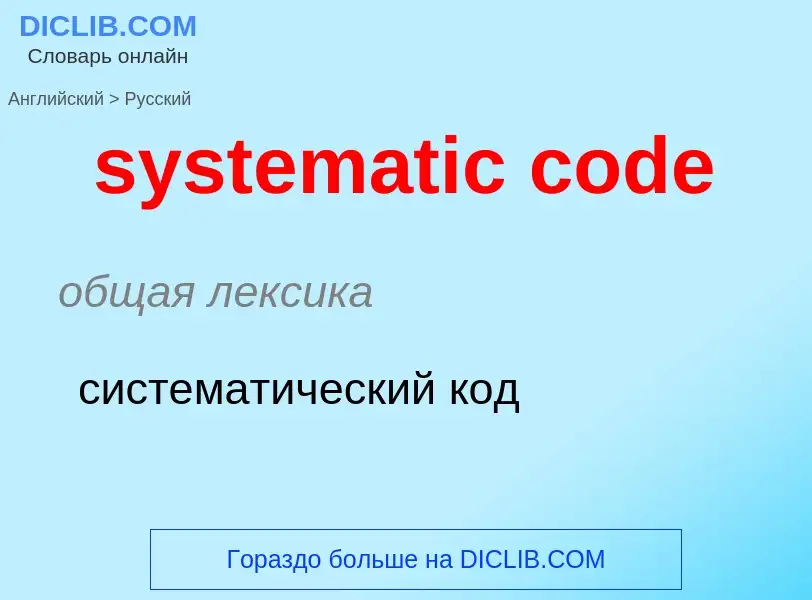Μετάφραση και ανάλυση λέξεων από την τεχνητή νοημοσύνη ChatGPT
Σε αυτήν τη σελίδα μπορείτε να λάβετε μια λεπτομερή ανάλυση μιας λέξης ή μιας φράσης, η οποία δημιουργήθηκε χρησιμοποιώντας το ChatGPT, την καλύτερη τεχνολογία τεχνητής νοημοσύνης μέχρι σήμερα:
- πώς χρησιμοποιείται η λέξη
- συχνότητα χρήσης
- χρησιμοποιείται πιο συχνά στον προφορικό ή γραπτό λόγο
- επιλογές μετάφρασης λέξεων
- παραδείγματα χρήσης (πολλές φράσεις με μετάφραση)
- ετυμολογία
systematic code - translation to ρωσικά
общая лексика
систематический код
вычислительная техника
свёрточный код
Ορισμός
Βικιπαίδεια
In coding theory, a systematic code is any error-correcting code in which the input data is embedded in the encoded output. Conversely, in a non-systematic code the output does not contain the input symbols.
Systematic codes have the advantage that the parity data can simply be appended to the source block, and receivers do not need to recover the original source symbols if received correctly – this is useful for example if error-correction coding is combined with a hash function for quickly determining the correctness of the received source symbols, or in cases where errors occur in erasures and a received symbol is thus always correct. Furthermore, for engineering purposes such as synchronization and monitoring, it is desirable to get reasonable good estimates of the received source symbols without going through the lengthy decoding process which may be carried out at a remote site at a later time.

![Shift-register for the (7, [171, 133]) convolutional code polynomial. Branches: <math>h^1 = 171_o = [1111001]_b</math>, <math>h^2 = 133_o = [1011011]_b</math>. All of the math operations should be done by modulo 2. Shift-register for the (7, [171, 133]) convolutional code polynomial. Branches: <math>h^1 = 171_o = [1111001]_b</math>, <math>h^2 = 133_o = [1011011]_b</math>. All of the math operations should be done by modulo 2.](https://commons.wikimedia.org/wiki/Special:FilePath/Conv code 177 133.png?width=200)

![Interleaving]] and Deinterleaving - code words separation increasing in time domain and to avoid bursty distortions. Interleaving]] and Deinterleaving - code words separation increasing in time domain and to avoid bursty distortions.](https://commons.wikimedia.org/wiki/Special:FilePath/GSM convol code.png?width=200)
![increases exponentially]] with constraint lengths, limiting these more powerful codes to deep space missions where the extra performance is easily worth the increased decoder complexity. increases exponentially]] with constraint lengths, limiting these more powerful codes to deep space missions where the extra performance is easily worth the increased decoder complexity.](https://commons.wikimedia.org/wiki/Special:FilePath/Lenss.png?width=200)

![Convolutional codes with 1/2 and 3/4 code rates (and constraint length 7, Soft decision, 4-QAM / QPSK / OQPSK).<ref>[https://ch.mathworks.com/help/comm/ug/punctured-convolutional-coding-1.html Punctured Convolutional Coding (MathWorks)]</ref> Convolutional codes with 1/2 and 3/4 code rates (and constraint length 7, Soft decision, 4-QAM / QPSK / OQPSK).<ref>[https://ch.mathworks.com/help/comm/ug/punctured-convolutional-coding-1.html Punctured Convolutional Coding (MathWorks)]</ref>](https://commons.wikimedia.org/wiki/Special:FilePath/Soft34.png?width=200)
![A turbo code with component codes 13, 15.<ref>[http://www.scholarpedia.org/article/Turbo_codes Turbo code]</ref> Turbo codes get their name because the decoder uses feedback, like a turbo engine. Permutation means the same as the interleaving. C1 and C2 are recursive convolutional codes. Recursive and non-recursive convolutional codes are not so much different in BER performance, however, recursive type of is implemented in Turbo convolutional codes due to better interleaving properties.<ref>Benedetto, Sergio, and Guido Montorsi. "[https://ieeexplore.ieee.org/abstract/document/390945/ Role of recursive convolutional codes in turbo codes]." Electronics Letters 31.11 (1995): 858-859.</ref> A turbo code with component codes 13, 15.<ref>[http://www.scholarpedia.org/article/Turbo_codes Turbo code]</ref> Turbo codes get their name because the decoder uses feedback, like a turbo engine. Permutation means the same as the interleaving. C1 and C2 are recursive convolutional codes. Recursive and non-recursive convolutional codes are not so much different in BER performance, however, recursive type of is implemented in Turbo convolutional codes due to better interleaving properties.<ref>Benedetto, Sergio, and Guido Montorsi. "[https://ieeexplore.ieee.org/abstract/document/390945/ Role of recursive convolutional codes in turbo codes]." Electronics Letters 31.11 (1995): 858-859.</ref>](https://commons.wikimedia.org/wiki/Special:FilePath/Turbo codes scheme.png?width=200)


